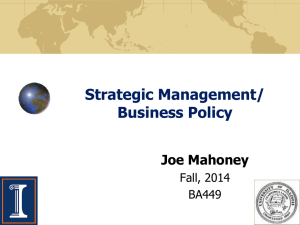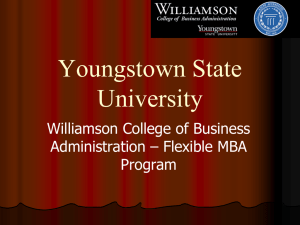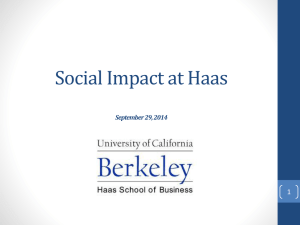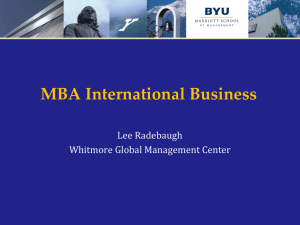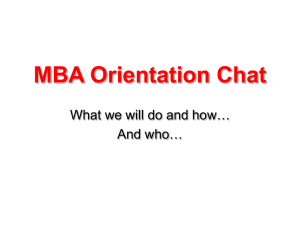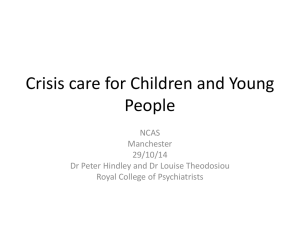Reality Check: The Importance of Learning about
advertisement
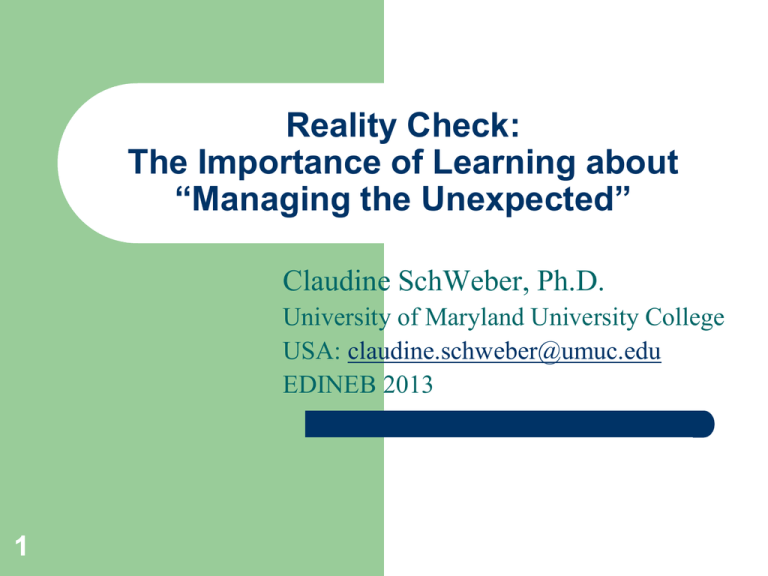
Reality Check: The Importance of Learning about “Managing the Unexpected” Claudine SchWeber, Ph.D. University of Maryland University College USA: claudine.schweber@umuc.edu EDINEB 2013 1 Reality of today’s work environment 2 Varied business crises: natural disaster, economic competition, human error Business continuity/ continuity of operations (coop) threatened 40% of USA companies that experienced a disaster, do not re-open (data 2000) Challenges for business 3 “Managing the unexpected” –Weick & Sutcliffe (2007) Leaders not equipped to deal with/ manage crises; (De Cremer, 2012) Primary attention to coop=Emergency management and homeland security groups Business education challenges 4 Leading in ‘unexpected’ environments not a focus Increasing adult student population: may have experience with crisis environment Media environment today organization cannot control the messages (internal, external) Challenge: how to prepare and educate future leaders to deal with reality “making decisions in unfamiliar contexts” (Winter, 2007) Business education “blind spot” (De Cremer, 2012) Pilot Study: the education of MBA students Purpose 1: examine the extent to which MBA programs in USA offer coursework in ‘managing the unexpected’ – 5 Proposition: Bus. Ed programs are not preparing MBA students for today’s crisis environment Purpose 2: offer content, literature suggestions Pilot Study: method 1) 20 AACSB schools with MBA in USA selected: 10 private and 10 public institutions – Selection included ‘elite’ and standard institutions, geographical diversity 2) Information about courses obtained from web: title, content, level (full-time, executive, part-time), description 3) Relevance for study based on title+course description, etc. Description needed to indicate not a routine leadership or change course, but dealt with decision uncertainty, disaster/ crisis management 4) Courses with description/ content showed crisis management orientation marked CM YES; perhaps, such as improvisational leadership marked CM Maybe; others marked CM No Summary chart developed. 6 Pilot study: method -private institutions 7 Harvard Business School MIT/Sloan School of Management Duke University Thunderbird Tulane University University of Pennsylvania/ Wharton Stanford University Cornell University University of Chicago Northwestern University/ Kellogg School of Management Method: Public institutions 8 University of Maryland/ Smith School University of California, Berkeley University of Texas, Austin University of Michigan University of Buffalo University of North Carolina, Chapel Hill University of Virginia/ Darden School Georgia State University University of Colorado Arizona State University Results: CM YES*--Private Schools with CM-YES = 4 private and 4 public institutions private: --Harvard, “Acting in Time” --MIT/Sloan, “Managing in Adversity” --NWestern/Kellogg, “Analytical Approach to Uncertainty”; “Strategic Crisis Management” --Univ Pa/ Wharton, “Managing Organizational Change” * Often based on course description and title—no syllabus 9 Results: CM YES*-public Public – Univ. Texas Austin, “ Managing Complexity”; “Crisis Management” – Univ. Michigan, “Business Leadership in Changing Times” – Univ. Buffalo, “Crisis Management” – Univ. Virginia/Darden, “Decision Analysis” * Often based on course description and title—no syllabus 10 Examples of CM-Yes courses Private Harvard B.S.: “Acting in Time” --year 2, elective http://www.hbs.edu/coursecatalog/1518.html “Leaders of businesses and other organizations repeatedly face a wide range of major hazards to their organizations, their business prospects, their property, their people, their communities - and to themselves…[these pose] enormous leadership challenges for companies, agencies… How do we best build strategies and organize ourselves and our enterprises to minimize and cope with the challenges and losses that might otherwise flow from events like these? …This is a strategy and leadership capstone course…for anyone who …will lead an organization that faces large-scale risks…” 11 CM YES-example/ private MIT/Sloan School: Managing in Adversity 15.966; http://mitsloan.mit.edu/mba/program-components/personalizedcurriculum/electives/ Elective-Special seminar subject “…Top Management Perspective. It assumes that the student is the CEO of a going concern and is faced with a major adversity — a problem way out of the ordinary and one which takes cool judgment, hard number pushing, immediate decision making, extraordinary public relations… [using the case method], show [companies] facing extreme adversity … which require an immediate attention. Further, the company will almost always have some limited resource — time, money, or talent.” 12 CM YES-- example/private Northwestern University, Kellogg School: Executive program --Analytical Approach to Uncertainty http://www.kellogg.northwestern.edu/Programs/EMBA/Courses_Curric ulum/Core_Courses.aspx : Introduces fundamental probabilistic concepts that enable managers to make critical business decisions in the face of uncertainty --strategic crisis management http://www.kellogg.northwestern.edu/Programs/EMBA/Courses_Curric ulum/Advancedcourses.aspx Provides conceptual tools for managers in high-pressure, complex crisis situations; Topics include management and media, dealing with activists and interest groups, and surviving legal, legislative and regulatory challenges. 13 CM YES-example/private Wharton, University of Pennsylvania: Managing Organizational Change MGMT 773 https://mgmt.wharton.upenn.edu/ Full-time program “During the last decade it has become clear that in the global economy, firms must constantly adapt to changing technological, competitive, demographic and other environmental conditions in order to survive and prosper. The importance of acquiring the knowledge and tools for changing organizations successfully cannot be overemphasized…” 14 CM YES—examples from Public institutions University at Buffalo. Crisis Management MGB 620; http://mgt.buffalo.edu/programs/pmba/curriculum/course descriptions#gm --professional MBA; rotating theme courses “Crises are everyday occurrences in organizations. For example, companies deal with crises associated with defective products such as Toyota in the USA, Europe and Japan. Governments are also faced with crises such as the 9/11 Terrorist Attacks and Hurricane Katrina…this course examines the nature of crises and incorporates topic from …marketing, management, public relations…Issues [covered] include crisis management including risk assessment, crisis prevention, crisis preparation, crisis recognition, crisis containment, and post crisis assessment.” 15 CM YES-example/public instits. University of Michigan- Business Leadership in Changing Times MO611 – elective http://www.bus.umich.edu/Academics/Departments/MO “The objective of this course is to develop a useful approach for recognizing and dealing with rapid change in business. This course deals with business leadership during periods of rapid change and managing a business during difficult times. It focuses on the early recognition of, methods of coping with, ways of learning from, and prevention of critically disruptive situations…” 16 CM YES—example/public instits. University of Texas/Austin --full-time program http://www.mccombs.utexas.edu/MBA/Full-time/Academics/Curriculum --Managing Complexity MIS 382N.5 – “The world and the organizations in it are increasingly complex and the future is increasingly uncertain. Conventional management approaches are clearly not adequate to deal with these emerging realities…” --Crisis Management MAN 385--What do Somalia, Shuttle Challenger, and 9/11 have in common? They were all unexpected crisis events that shook the nation and challenged the national policy apparatus. This course affords students the opportunity to examine and analyze policy formulation and implementation…under specialized circumstances of unforseen crises…” 17 CS YES-example/public instits. University of Virginia/ Darden http://www.darden.virginia.edu/web/MBA Executive program-core Decision Analysis GBUS 735. “…framing, analyzing and proactively managing decisions involving uncertainty, whether uncertainty results from general conditions or the actions of competitors. The course focuses on making explicit the uncertainty we face so that it can be objectively analyzed…” 18 Conclusions 19 Study indicates that there is a beginning of work in the area of ‘managing the unexpected’ in both private and public institutions Primarily available in part-time programs; working professionals (?) Not consistently available: elective, rotating special topic, executive, professional MBA, full-time or parttime; found in IT or management areas limitations 20 Used only web as a source Selection of institutions May only have title + few sentence description Occasionally more detail and once, syllabus (Harvard) interpretation of ‘uncertainty’ focus Suggestions 21 Examine and apply, as appropriate, work in emergency management, homeland security Use systemic approach to show inter-dependencies Include ‘resilience’ as a core theme—whether stand alone course or within ‘change’ or ‘leadership’ coursework. Themes/concepts: sensemaking, bricolage, organizational agility, making ‘decisions in unfamiliar contexts’ Reality check 22 Management students need to be prepared to manage in the real world “Only by going forward is it possible to know what the options are for going further forward” (Sidney Winter, p 526) THANK YOU Suggestions for further research directions, institutions, courses very welcome claudine.schweber@umuc.edu 23
